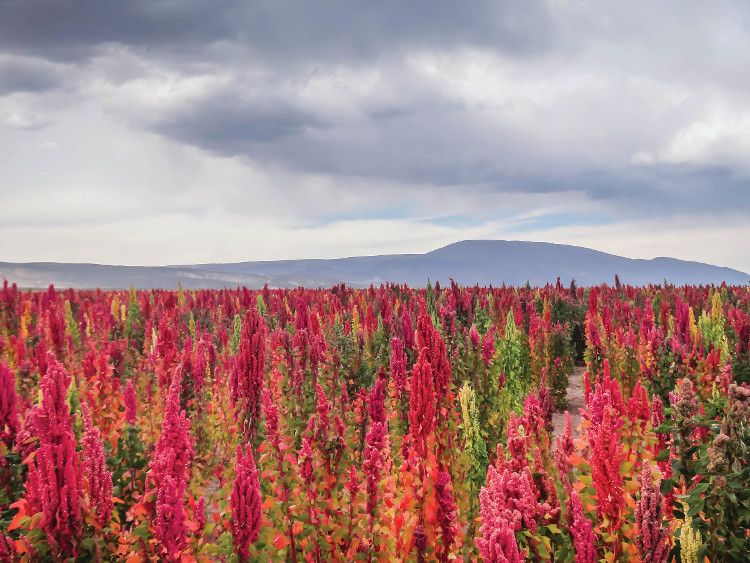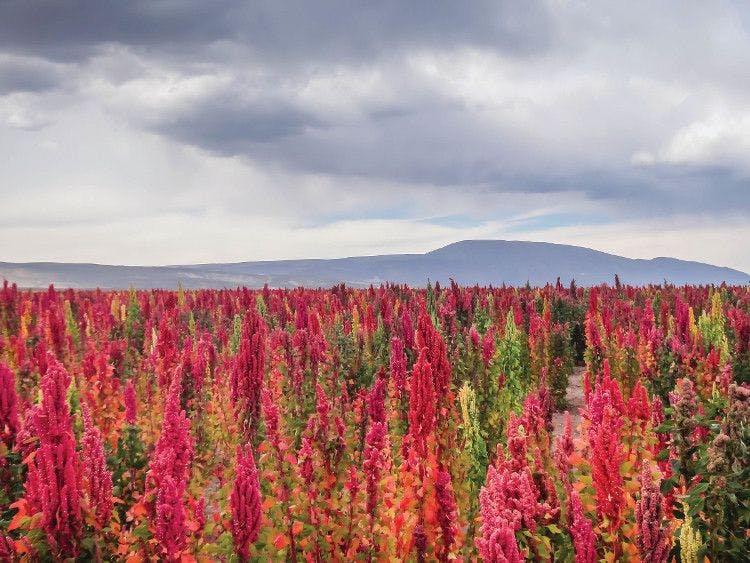Nutritional Outlook’s 2018 Best of the Industry Awards, Ingredient Supplier: The Annex by Ardent Mills
The Annex by Ardent Mills is helping to change the landscape of ancient grains in North America.
Image courtesy Bjoern - Stock.adobe.com

Ancient grains are a small percentage of the overall grains market, but there is no denying their growing popularity. “What’s old is new again” is the saying often used when discussing trending grains like quinoa, amaranth, millet, sorghum, teff, spelt, einkorn, and more. These specialty grains are increasingly favored by consumers who enjoy not only the eating experience but also the healthy halo often ascribed to ancient and heirloom grains.
The numbers reflect growing consumption. In January 2018, for instance, market researcher The NPD Group reported double-digit year-over-year growth in case shipments of ancient grains to U.S. foodservice outlets specifically.1 The company reported: “Case shipments of quinoa, which is the most widely used ancient grain, increased by 18.5% in the year ending October 2017 compared to the same period a year ago. Two ancient grains not as commonly known-spelt, a distinct type of whole-grain wheat, and farro, a whole grain similar to barley, quinoa, and wheat berries-also realized double-digit growth in case shipments. Shipments of amaranth, a staple food of the Aztecs and comparable to rice or maize, increased by 19.4% in the period.” In February 2018, market researcher Euromonitor named ancient grains one of the “8 Food Trends for 2018” alongside fermented foods and healthy fats.2
Consumers can’t get enough of ancient grains these days-and, therefore, neither can food manufacturers, foodservice firms, and artisan bakers. But it may surprise some to learn that while commodity grains are grown aplenty in the United States, many of the ancient grains popular in the North American market are actually not grown in North America. Grains like quinoa, amaranth, and teff are, in large part, still imported. Quinoa, for example, is heavily sourced from South America. (Other ancient and heirloom grains, such as sorghum, millet, spelt, emmer, and White Sonora, are gaining popularity and are being grown on more farms in North America.)
One company is helping to grow the ancient grains supply in North America with an initiative started earlier this year. At the March 2018 Natural Products Expo West trade show, leading North American flour and grain innovator Ardent Mills (Denver, CO) launched a new business unit called The Annex by Ardent Mills (“The Annex”). The Annex’s sole purpose is to grow the company’s specialty business, which includes ancient and heirloom grains, organic grains, sprouted grains, pulses, and more. The Annex not only works closely with farmers and crop breeders to increase acreage of ancient grains in North America, it offers formulating and innovation services downstream to help manufacturers learn how to incorporate these grains in their finished products-truly providing support from the ground up.
“We look at grains in our portfolio and at how we can grow these grains in the U.S. We want to help the family farms we work with diversify and add these grains into their rotation,” says Shrene White, general manager of The Annex.
First, the company offers farmers the expertise of the public and private crop breeders it works with. Through its network, The Annex helps farmers who would like to diversify their crops by including more ancient grains and heirloom grains and pulses answer such questions as: “Is this a spring crop? Is this a winter crop? How does it fit into my rotation? Do I live in an area that is conducive to growing something like a quinoa or a teff? All of those things need to be taken into consideration when farmers are looking to add a grain like that into their rotation,” says White. “We can work with the farmers on planting the best varieties that will work best in climates that we have here across the United States.”
Diversifying their crop portfolio gives farmers added security as well as the chance to participate in new, emerging markets. “It allows the family farms we work with to participate in new, growing markets that they maybe wouldn’t have been able to participate in before,” White says.
It’s no wonder that farmers are interested in what The Annex offers. “We get calls weekly from these farmers who are looking to do something different, who are looking to diversify what they’re doing on the farm,” White says. Some farmers also see sustainability benefits, “where rotating with a sorghum or a quinoa will help save water, or rotating with some type of chickpea or a legume might be a nitrogen fixer for an organic farmer,” she explains.
Working with more farmers mitigates The Annex’s own risk, too. “It helps us diversify our growing regions so we’re not so dependent on one area,” White says. “If you get a hailstorm or you get rained on during harvest, you haven’t ruined your whole supply chain.”
The payoff is a consistent product supply. “We can offer our customers long-term contracts because we know that we’ve got farmers in all areas of the country that are growing grains for us,” White says. The Annex allows the company to be more nimble and proactive at meeting its customers’ needs by putting supply local and readily at hand. And it allows the company to engage in more markets. “Products and formats provided by The Annex are opening doors for Ardent Mills to participate in new areas within foodservice, the snack market, the pet food market, and the distilling market. It’s really opening up new channels for us that we just wouldn’t have been able to supply [to] had we just stayed with our core commodity flour business,” White says.
The Annex aims to keep increasing the number of farmers it works with. Through relationships built at Ardent Mills, the firm says it is contract growing with family farms in just about every state west of the Mississippi today.
White adds, “As we’ve gone out and talked more about The Annex and we’ve participated on different panels across the United States, we always seem to have farmers who make contact with us and want to come in and be part of the program. I think some of that is just knowing that we have a good reputation of supporting farmers.”
The Annex supports farmers by guaranteeing the company will buy the farmers’ crops at a set price and set quantity. “If we ask them to plant something, we’re going to stand behind it, and we’re going to buy that grain and find a way to use it,” White says. “Farmers know that if they’re growing something in our program, they’re going to get the support they need. They’re going to get paid for it, they’re going to be able to deliver the grain, and we’re going to find a home for it.”
That’s where The Annex shines: helping participants up and down the supply chain work with ancient and heirloom grains. The Annex offers the support of R&D and other staff to help end-product manufacturers find new and innovative ways of formulating with ancient grains and other specialty ingredients-for instance, “understanding the baking characteristics of a particular grain,” White says, or developing new ancient grain formats such as crisps, flakes, and individual quick frozen formats. Breeders can also help “to get traits into grains that are going to help our customers and the end consumer,” White adds.
White describes The Annex as a team of “15 really specialized people.” The team includes food/R&D scientists, sales and marketing specialists, regulatory/operations advisors, and even a culinary chef and a bakery. “These are people who can work with an R&D person, work with a marketing person, with the company, to really help develop a product from the ground up,” she says. “We’re not just going in and selling something; we want to be able to work with our customers all the way from innovation, R&D, to that final product. We can go from breeding, growing, innovation, supply chain, all the way to a finished flour or a loaf of bread.”
The Annex also has the full support of Ardent Mills behind it. “We fully understand that the core business is what’s allowing us to do all the cool, funky stuff we’re doing in The Annex,” White says. “That’s what keeps the lights on for us.”
By helping manufacturers create new ancient grain products consumers will love, and by reducing manufacturers’ concerns about stable supply-thereby making them less anxious about formulating with ancient grains-The Annex is helping make ancient and heirloom grains more accessible, which will only increase demand for ancient grains in the first place. “Making the right connections, both with the farmers and the customer, and understanding what is driving these trends is really helping us connect that whole supply chain,” says White.
It really comes full circle, White says. And it’s making a difference. “Take White Sonora as an example,” she says. “We started a few years ago with just a few acres of White Sonora, and we’ve been able to work with farmers up in the Pacific Northwest to expand acres and do seed grow-outs. This is allowing our customers to add White Sonora to their products and know they’re going to have a consistent supply.” She says, “I think North American quinoa is another really good example where we’re working all the way from breeding work with new varieties that are more adaptable to North America and helping farmers understand how to grow quinoa and get it adapted into their rotation.”
Can The Annex ultimately change the profile of the North American ancient grains landscape? White believes so. “I do,” she says. “I think we’ve already seen it starting to take place.”
She continues: “Do I ever think ancient grains are going to be as big as the commodity market? No. But I think we’re going to continue to find new ways to innovate and new, unique formats and ways to get these grains into the diet.”
References:
- The NPD Group. “Everything Ancient Is New Again: Case Shipments of Ancient Grains to Foodservice Outlets Increased by Double-Digits.” January 3, 2018. Accessed November 8, 2018.
- Euromonitor Passport. “8 Food Trends for 2018.” February 2018. Accessed November 8, 2018.

Prinova acquires Aplinova to further increase its footprint in Latin America
April 7th 2025Prinova has recently announced the acquisition of Brazilian ingredients distributor Aplinova, which is a provider of specialty ingredients for a range of market segments that include food, beverage, supplements, and personal care.



















